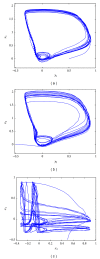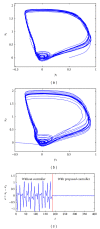Synchronization of coupled different chaotic FitzHugh-Nagumo neurons with unknown parameters under communication-direction-dependent coupling
- PMID: 25101140
- PMCID: PMC4101220
- DOI: 10.1155/2014/367173
Synchronization of coupled different chaotic FitzHugh-Nagumo neurons with unknown parameters under communication-direction-dependent coupling
Abstract
This paper investigates the chaotic behavior and synchronization of two different coupled chaotic FitzHugh-Nagumo (FHN) neurons with unknown parameters under external electrical stimulation (EES). The coupled FHN neurons of different parameters admit unidirectional and bidirectional gap junctions in the medium between them. Dynamical properties, such as the increase in synchronization error as a consequence of the deviation of neuronal parameters for unlike neurons, the effect of difference in coupling strengths caused by the unidirectional gap junctions, and the impact of large time-delay due to separation of neurons, are studied in exploring the behavior of the coupled system. A novel integral-based nonlinear adaptive control scheme, to cope with the infeasibility of the recovery variable, for synchronization of two coupled delayed chaotic FHN neurons of different and unknown parameters under uncertain EES is derived. Further, to guarantee robust synchronization of different neurons against disturbances, the proposed control methodology is modified to achieve the uniformly ultimately bounded synchronization. The parametric estimation errors can be reduced by selecting suitable control parameters. The effectiveness of the proposed control scheme is illustrated via numerical simulations.
Figures






Similar articles
-
Robust Adaptive Synchronization of Ring Configured Uncertain Chaotic FitzHugh-Nagumo Neurons under Direction-Dependent Coupling.Front Neurorobot. 2018 Feb 26;12:6. doi: 10.3389/fnbot.2018.00006. eCollection 2018. Front Neurorobot. 2018. PMID: 29535622 Free PMC article.
-
Robust synchronization of delayed chaotic FitzHugh-Nagumo neurons under external electrical stimulation.Comput Math Methods Med. 2012;2012:230980. doi: 10.1155/2012/230980. Epub 2012 Nov 1. Comput Math Methods Med. 2012. PMID: 23197990 Free PMC article.
-
Lag Synchronization of Noisy and Nonnoisy Multiple Neurobiological Coupled FitzHugh-Nagumo Networks with and without Delayed Coupling.Comput Intell Neurosci. 2022 Jun 2;2022:5644875. doi: 10.1155/2022/5644875. eCollection 2022. Comput Intell Neurosci. 2022. PMID: 35694576 Free PMC article.
-
Lag synchronization of coupled time-delayed FitzHugh-Nagumo neural networks via feedback control.Sci Rep. 2021 Feb 16;11(1):3884. doi: 10.1038/s41598-021-82886-x. Sci Rep. 2021. PMID: 33594138 Free PMC article.
-
On numerical simulations of integrate-and-fire neural networks.Neural Comput. 1998 Feb 15;10(2):467-83. doi: 10.1162/089976698300017845. Neural Comput. 1998. PMID: 9472491 Review.
Cited by
-
Unidirectional Synchronization of Hodgkin-Huxley Neurons With Prescribed Performance Under Transcranial Magneto-Acoustical Simulation.Front Neurosci. 2019 Oct 15;13:1061. doi: 10.3389/fnins.2019.01061. eCollection 2019. Front Neurosci. 2019. PMID: 31680807 Free PMC article.
-
Neural network control of fractional-order chaotic systems with unknown control direction.Heliyon. 2024 Feb 27;10(5):e26870. doi: 10.1016/j.heliyon.2024.e26870. eCollection 2024 Mar 15. Heliyon. 2024. PMID: 38444461 Free PMC article.
-
Modeling of inter-neuronal coupling medium and its impact on neuronal synchronization.PLoS One. 2017 May 9;12(5):e0176986. doi: 10.1371/journal.pone.0176986. eCollection 2017. PLoS One. 2017. PMID: 28486505 Free PMC article.
-
Robust Adaptive Synchronization of Ring Configured Uncertain Chaotic FitzHugh-Nagumo Neurons under Direction-Dependent Coupling.Front Neurorobot. 2018 Feb 26;12:6. doi: 10.3389/fnbot.2018.00006. eCollection 2018. Front Neurorobot. 2018. PMID: 29535622 Free PMC article.
-
Presence of a Chaotic Region at the Sleep-Wake Transition in a Simplified Thalamocortical Circuit Model.Front Comput Neurosci. 2016 Sep 1;10:91. doi: 10.3389/fncom.2016.00091. eCollection 2016. Front Comput Neurosci. 2016. PMID: 27660609 Free PMC article.
References
Publication types
MeSH terms
LinkOut - more resources
Full Text Sources
Other Literature Sources
Miscellaneous

